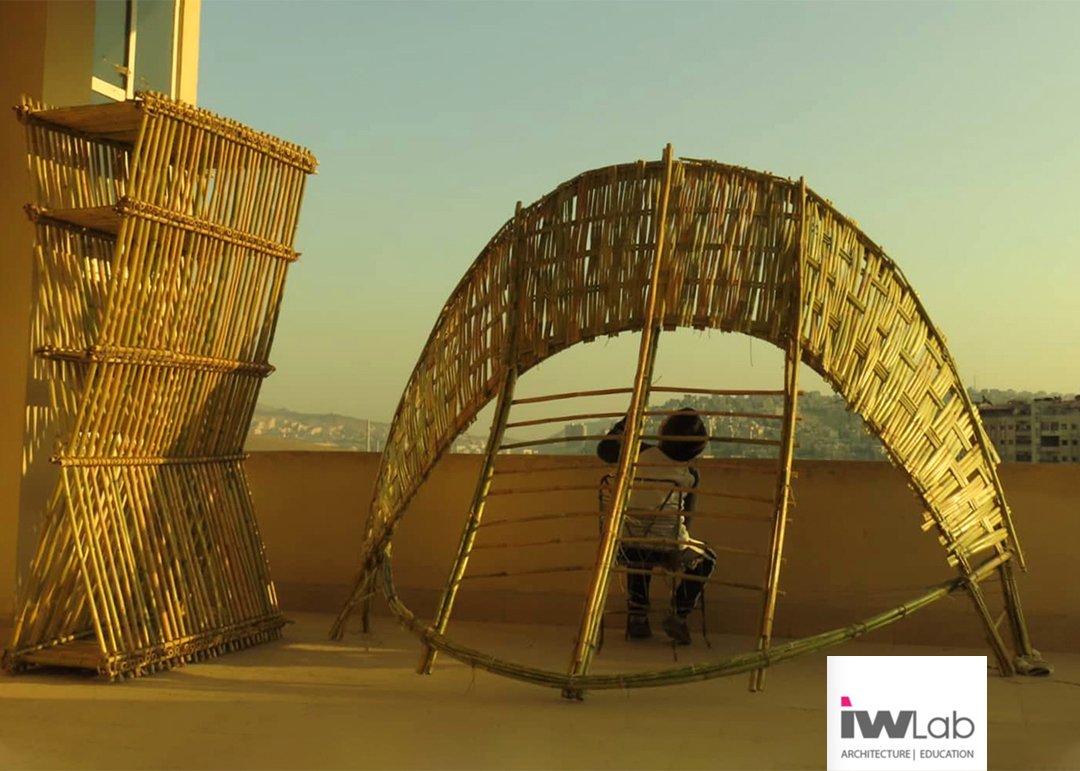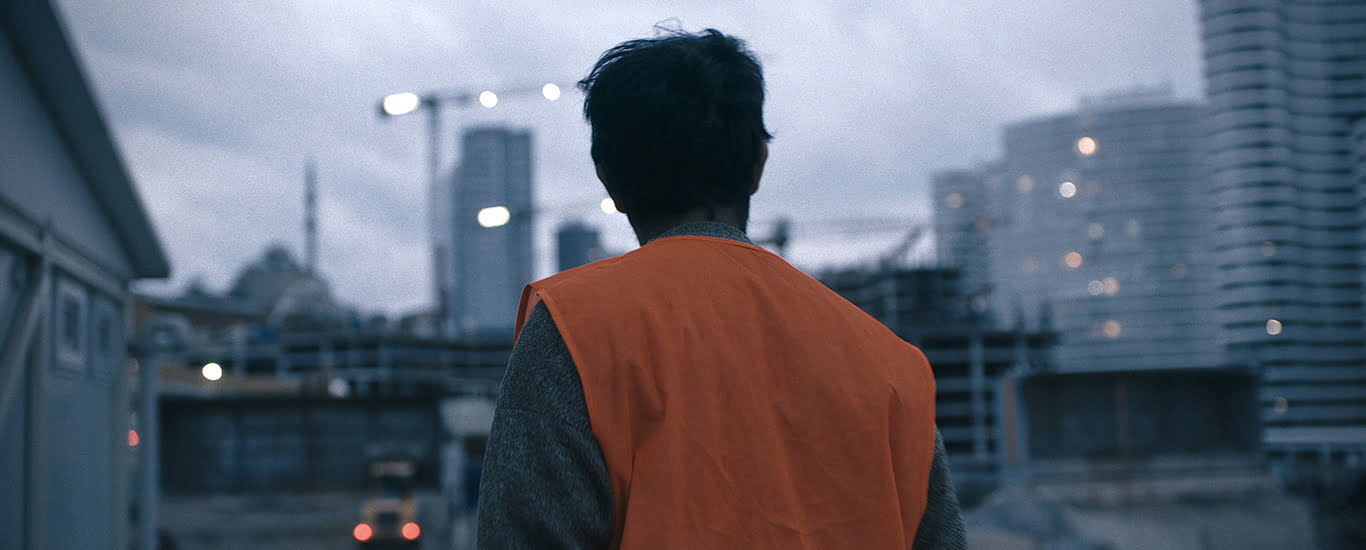I dream of turning constructions sites into spaces of dialogue and creativity
Tell me about your upbringing EG. Where were you born?

I was born and raised in Saudi Arabia. My parents are both teachers. Like tens of thousands of teachers from Egypt and the Levant, they headed to a gulf country in the eighties to work for better salaries. Living in Najran the south of Saudi Arabia, the border of Yemen, our relationship to Saudi Arabia was always framed as temporary stay away from homeland. Waiting for summer vacation to go the Damascus, we were always promised to return to Syria permanently, so we did in 1998. I was 14. During, the last year in Saudi Arabia, we lived in the desert. That year was probably the most influential on my upbringing for it framed a close relationship between nature, the built environment, and the notion of home. It was the first time that I could see how the three can be integrated, spending more time outside our house than inside it.
How has your birthplace and upbringing influenced your architecture practice and designs?
I never thought I would be an architect. I wanted to be a writer, and I fiercely tried to write poems since when we went back to Syria. At the age of 16, in 2000, I was part of a collective poetry book that was published in Damascus –unfortunately did not take any copies of that book when I left Syria.
After finishing high school, I entered the Faculty of Architecture because it was the best options that my grade allowed. But the open, beautifully moduled building of the faculty, designed by the late Bourhan Tayyara, was probably one of the main reasons behind my decision to stick with architecture.
Describe the cultural heritage that helps influence your work.
My hometown Jobar is the entrance to from Damascus to eastern Ghouta. Since 1960, the once an orchard with farmers and artisans had developed into a mixed between unfinished urban plans and the remnant of a village. Until 2010, Jobar still had a good share of courtyard mud houses the adjoined concrete building blocks. My grandparent’s house was one of them. Humble, accessible and full of plants, it formed a haven for us to visit after school or on weekends. This house, with its wooden ceilings and terrazzo flooring, defies the concept of heritage as taught in architectural education and preservation studies. It changes with seasons, it develops with the family, it does not care about the past nor the future, it is part of the family. The hybridization of Jobar and simplicity of my grandparent’s house taught me how to refuse heritage as mere preservation of identity, i.e. to keep things as they are. Heritage is a material of joy, playfulness, and creativity, it is about adding as much as it is about purification.
The old Fabric of Jobar, and many villages around Ghouta, were entirely ignored by historians and planners. Instead, Damascus was in focus. The city (Damascus) shadowed everything around it. Living in a peripheralized case taught me how to narrate and care about the heritage of the marginalized, the heritage of the everyday life that is ignored for it can not be objectified and quantified. Heritage as objects is a colonial legacy, and it has been framing cultures for many years. Therefore, I chose to tell stories in my studies of heritage instead of reporting static plans and sections. I see current everyday practices of living and building as important as old ones. This particular theme is the drive behind my interest in studying Informal Damascus, for example, which I consider part of the history of Damascus, if not at the core of it.
When did you arrive in the UK, and what was the catalyst?
In 2011, I travelled to Copenhagen for an internship at an Architectural Company. When I finished the course, clashes in Jobar was escalating into bombarding the whole area. We planned my family’s escape to Egypt, and I stayed in Denmark, working as an architect and a visual artist. My partner María José, a Spanish with a Damascene soul, and who I met in Damascus, came to Denmark too. We got married in 2012.
In 2013, I visited the University of Cambridge as part of the British Council’s Cultural Leadership International Program. I was planning on doing research that links vernacular knowledge to post-war reconstruction, that is, to rebuild as locally as possible. In 2015, I moved to Cambridge and started my MPhil in Architecture and Urban Studies. Looking at how local knowledge can be exchanged and developed, my MPhil was made into a PhD research on which I am currently working. It examined a Spanish low-cost vaulting technique, called thin-tile vaulting, and its possible application in contexts of limitations and scarcities, similar to those of post-war.
Describe your work and interest as an architect
I received my BA in Architecture in my hometown Damascus, where the built environment is an unfolding story that melds the past with the present and the future. In 2012, I began working in an architectural firm in Copenhagen, where, unlike in Syria, innovation sprang from abundance instead of scarcity. I came to Cambridge in 2015 to pursue an MPhil and subsequently a PhD on thin-tile vaulting, both of which took me to Spain to work with artisans and master builders for research and learning. These places are more than locations; they are cultures of understanding and interacting with the built environment. Although today building practices have been almost globally reduced to a singular model of drawings entangled in nets of codes, managements and bureaucracies, I consider them to be cultural practices first and foremost. Therefore, my work situates “Cultures of Making,” which I define as the relationship between the local knowledge and limitations to design and innovation, at the core of the ongoing discourse on diversity and environmental justice. Culture(s) in plural implies that we should have a dialogue between ways of making, import and export knowledge instead of building materials. I am interested in bridging vernacular cultures between geographies (mainly Syria and Spain) and between technologies. This particular theme has been the foundation of my work for the last five years; I have been studying and working with builders and artisans to understand and disseminate their knowledge and the way it relates to technology and design.
Describe the work that your architectural practice IWlab does…
IWlab started as a protest against the petrified definition of architectural practice in Syria. Graduated architects are usually transformed into trackers of applications of building permissions, roaming endlessly between the municipal offices. Architecture as a practice within its socio-economic context was not an option. I decided with my friend Iyas Shahin to found IW (Simply Iyas and Wesam) Lab. The Lab combines cultural programs with art and urban and heritage studies to promote a model of architectural practice that proactively negotiates and participates in the city. Between 2010 and 2012, we completed two urban installations, two heritage and architecture education programs for children, and research on Sarouja, a threatened historical area in Damascus.

When I moved to Denmark in 2012, we decided to continue in a different form, instead of giving up the lab. The lab then functioned as a bridge between activities in Syria and Denmark, we did several activities joining architecture students from both countries to talk and discuss the role architecture and urban planning during the times of crisis. IWlab has recently become a research and policy focus venture with projects about informality, environmental justice, and craft.

What have been your key points of achievement and success in these projects?
I have dear memories of our project Mabar (Passage) about teaching architecture and urban heritage to the young ones in Damascus in 2010-2011. We did these activities in the courtyard of a school that accommodates an old Damascene house in the old city. For a month, kids were working with us on reimagining the city, where it started, how it performed, and how it should be. The workshop was about heritage, indeed, but again, we dealt with it as a living matter that we can change and transform.
That is said, I think a more recent project is an achievement that I hope it sets a new path of IWlab work during these challenging times. Our lab has been working on the ignored reed weaving craft in Damascus. We have identified and collaborated with one of the few artisans left who work with reeds in Barada basin river, Hamid Alaita. Reed weaving at bulk scales is not usually interest of heritage preservationists who prefer products that can be nicely wrapped and sold to tourists. We are trying to propose a different value that comes from finding new applications for old techniques found and practiced in everyday life. At this stage, we have established this cooperation in terms of language, geometries, and new technologies by working with reed weaving artisan in Damascus. We are aiming at extending this project towards the production and testing of more elements and to find ways for artisans to have apprentice and designers to work them.
Please describe the architecture behind the informal settlements in Damascus, and how you hope to rebuild communities there.
Informal areas in Damascus was the research focus of IWlab since 2017. The interest comes from the pressure on the inhabitants of these areas in post-war state planning that, apparently, has no other solution than total clearance and urban renewal. We wanted to see what informal building is and what it can offer in the post-war reconstruction. Informal areas form more than half of Damascus. Instead of labelling it all as aggression to the city, cancer, or and back-warding urbanism, we propose to study it. We found that the dynamics in informal building is similar to how builders used to build in old Damascus. However, the latter is framed as outlaws and antagonized while builders in old Damascus were partners of state planning and courts. We decided to decode informal building into components that try to explain why informal settlements look the way they look. Manifested in inclusion, optimization, speed, and efficiency, our study composes the “informal observatory” where we have all these components showed and explained, hoping to demystify informal building as the first steps towards meaningful and positive intervening.
What has been a key accomplishment for you professionally?
One engaging outreach accomplishment that I am proud of is Urbegony. Through IWlab, I have used online communication and digital platforms to work with architecture students in Damascus during the hardest years of the crises (2013-2015), students in Syria were isolated from academic and teaching activities outside the country. Preliminary workshops developed into an idea to establish a collective platform in 2016, Urbegony was made by and for Syrian students inside and outside the country. Within tutoring programmes, the platform works with students on personal projects where tools from architectural expression such as drawings, maps and models are used for expressing feelings and ideas about their neighbourhoods, homes or asylums. Urbegony has since exhibited in Venice, London, and Cambridge.
Your research as a PhD student of architecture for the University of Cambridge led to some innovative findings concerning construction technology, craftsmanship and techniques. Please explain your findings and how you’ve been able to apply them into your work. (please discuss project Situ)
My research work connects technology to builders’ experiences for solutions rooted in responding to site limitations. In today’s response to environmental challenges, the answers are usually framed as advanced tools such as 3D printing and precision fabrication. My work highlights another possible route that relies on the local and rooted “cultures of making”, represented by the vernacular knowledge and everyday construction. I work on linking this knowledge to contemporary tools of design and construction; the use of off-site technology in the optimization of on-site technology.
I love “jigs” in buildings, and I think they are mediums of knowledge. Jigs are localized solutions; they require little infrastructure. They represent the opposite of today’s urge to make a machine that builds everything. Therefore, I work to provide “jigs” as tools that can teach how to build. In my first thin-tile project in-situ, I worked closely with Spanish master builders to extrapolate their knowledge into systems of building so that novice builders can build what experts can build. In 2018, I designed a pavilion in Valencia in Cevisama Fair where I explored craft-based prefabrication that can save time but requires no big-scale cranes and machinery. Recently, I am working on how to recycle rubble in war-torn areas into vaults for ceilings. All the previous projects were in dialogue with builder masters from the one hand, and tools of digitization and analysis on the other hand.
Finally, I am also working on a more artistic front, trying to listen to materials expressions and play with their constrains. One of my latest art projects is “It washes away”, which I worked on with my friend Sofia Singler. The project is a series of sculptures of one window from Khan al-Wazir in Aleppo, Syria. But rather than ashlar and quarry stones the sculptures are built out of another Aleppian material: Aleppo soap. The soap washes away and exposes the fragility of the built heritage. However, I was surprised by the persistent of the smell, exposing endurance of and vitality of memories I forgot that I had.
Describe the impact that your projects have had on people living in Syria. If the project has not yet reached Syria, what impact do you hope it will have.
I think “construction” is a dialogue. My hope for my future research and work on Syria is in its core about establishing the dialogue on construction between Spain, Syria, and the UK. I think an exchange of vernacular knowledge on building vaults is needed and healthy. While concluding my research on thin-tile vaulting, I am working now on establishing a curriculum for training on vernacular construction, a proposal for recycling building rubble into vaults, and a prefabricated system of vaulting. I hope soon the three can have an impact in Syria and within Syrian refugees in the Middle and East and Europe.
more info: iw-lab.com



